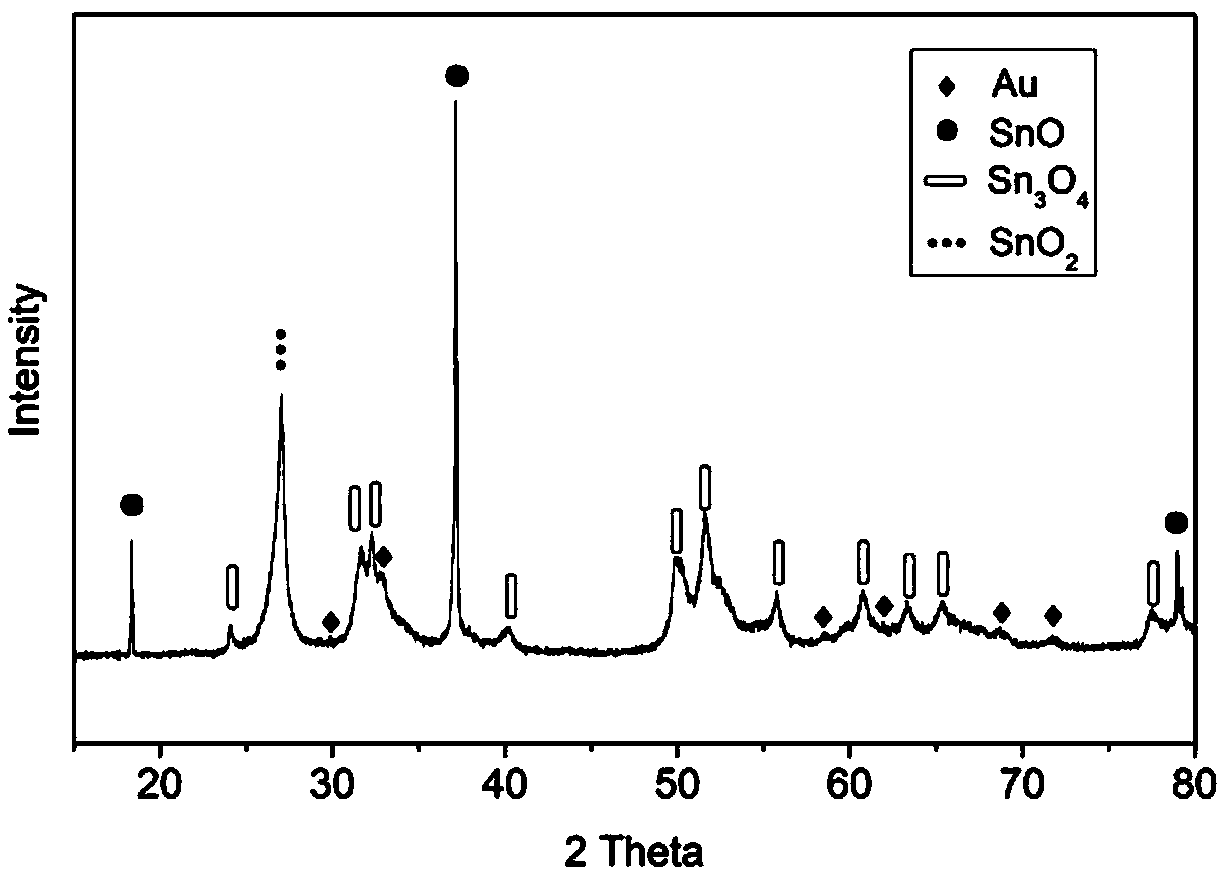Preparation method of Au modified SnO/Sn3O4/SnO2 nano composite photocatalytic material
A photocatalytic material and nanocomposite technology, applied in the field of preparation of nanocomposite photocatalyst, can solve the problems of complex preparation process, unreliable loading, obvious hard agglomeration effect, etc., and achieve low preparation temperature, controllable shape and size, The effect of fast photogenerated carrier separation
- Summary
- Abstract
- Description
- Claims
- Application Information
AI Technical Summary
Problems solved by technology
Method used
Image
Examples
Embodiment 1
[0027] 1) get 1mmol analytically pure stannous acetate (C 4 h 6 O4Sn) and 0.8mmol of acetic acid (CH 3 COOH) was fully dissolved in 2 mL of absolute ethanol, and then 0.5 mmol of ascorbyl palmitate (C 22 h 38 o 7 ) and 13mL of deionized water to obtain solution A;
[0028] 2) Take 1mmol analytically pure auric acid chloride (HAuCl 4 ) and 0.01 mmol analytically pure acetic acid (CH 3 COOH) was fully dissolved in 7mL of deionized water to obtain solution B;
[0029] The steps 1 and 2) in the whole process, use a constant temperature magnetic stirring device to carry out continuous magnetic stirring at a temperature of 5° C. in an ice-water bath composed of crushed ice and water;
[0030] 3) Add solution B dropwise to solution A at a speed of 30 drops / min to form a mixed solution, then adjust the pH value of the mixed solution to 5 with a NaOH solution with a concentration of 2mol / L, and the whole process is formed in a mixture of crushed ice and water. Use a constant te...
Embodiment 2
[0034] 1) get 1mmol analytically pure stannous acetate (C 4 h 6 O4Sn) and 1.2mmol of acetic acid (CH 3 COOH) was fully dissolved in 7mL of absolute ethanol, and then 5mmol of ascorbyl palmitate (C 22 h 38 o 7 ) and 18mL of deionized water to obtain solution A;
[0035] 2) Take 1mmol analytically pure auric acid chloride (HAuCl 4 ) and 0.5 mmol analytically pure acetic acid (CH 3 COOH) was fully dissolved in 12mL of deionized water to obtain solution B;
[0036] The steps 1 and 2) in the ice-water bath composed of crushed ice and water use a constant temperature magnetic stirring device to carry out continuous magnetic stirring at a temperature of 30°C;
[0037] 3) Add solution B dropwise to solution A at a rate of 45 drops / min to form a mixed solution, then use a NaOH solution with a concentration of 3mol / L to adjust the pH value of the mixed solution to 6. Use a constant temperature magnetic stirring device in an ice-water bath to continuously magnetically stir it at ...
Embodiment 3
[0042] 1) get 1mmol analytically pure stannous acetate (C 4 h 6 O4Sn) and 1.6mmol of acetic acid (CH 3 COOH) was fully dissolved in 12mL of absolute ethanol, and then 9mmol of ascorbyl palmitate (C 22 h 38 o 7 ) and 23mL of deionized water to obtain solution A;
[0043] 2) Take 1mmol analytically pure auric acid chloride (HAuCl 4 ) and 1.0 mmol analytically pure acetic acid (CH 3 COOH) was fully dissolved in 15mL of deionized water to obtain solution B;
[0044] The steps 1 and 2) in the whole process, use a constant temperature magnetic stirring device to carry out continuous magnetic stirring at a temperature of 50° C. in an ice-water bath composed of crushed ice and water;
[0045] 3) Add solution B dropwise to solution A at a rate of 60 drops / min to form a mixed solution, then use a NaOH solution with a concentration of 5mol / L to adjust the pH value of the mixed solution to 8. Use a constant temperature magnetic stirring device in an ice-water bath to continuously ...
PUM
 Login to View More
Login to View More Abstract
Description
Claims
Application Information
 Login to View More
Login to View More - R&D
- Intellectual Property
- Life Sciences
- Materials
- Tech Scout
- Unparalleled Data Quality
- Higher Quality Content
- 60% Fewer Hallucinations
Browse by: Latest US Patents, China's latest patents, Technical Efficacy Thesaurus, Application Domain, Technology Topic, Popular Technical Reports.
© 2025 PatSnap. All rights reserved.Legal|Privacy policy|Modern Slavery Act Transparency Statement|Sitemap|About US| Contact US: help@patsnap.com

